Learn how to make sticky rice (without a bamboo basket steamer). This stovetop method of making Thai sticky rice is easy, using kitchen tools you will likely already have at home.
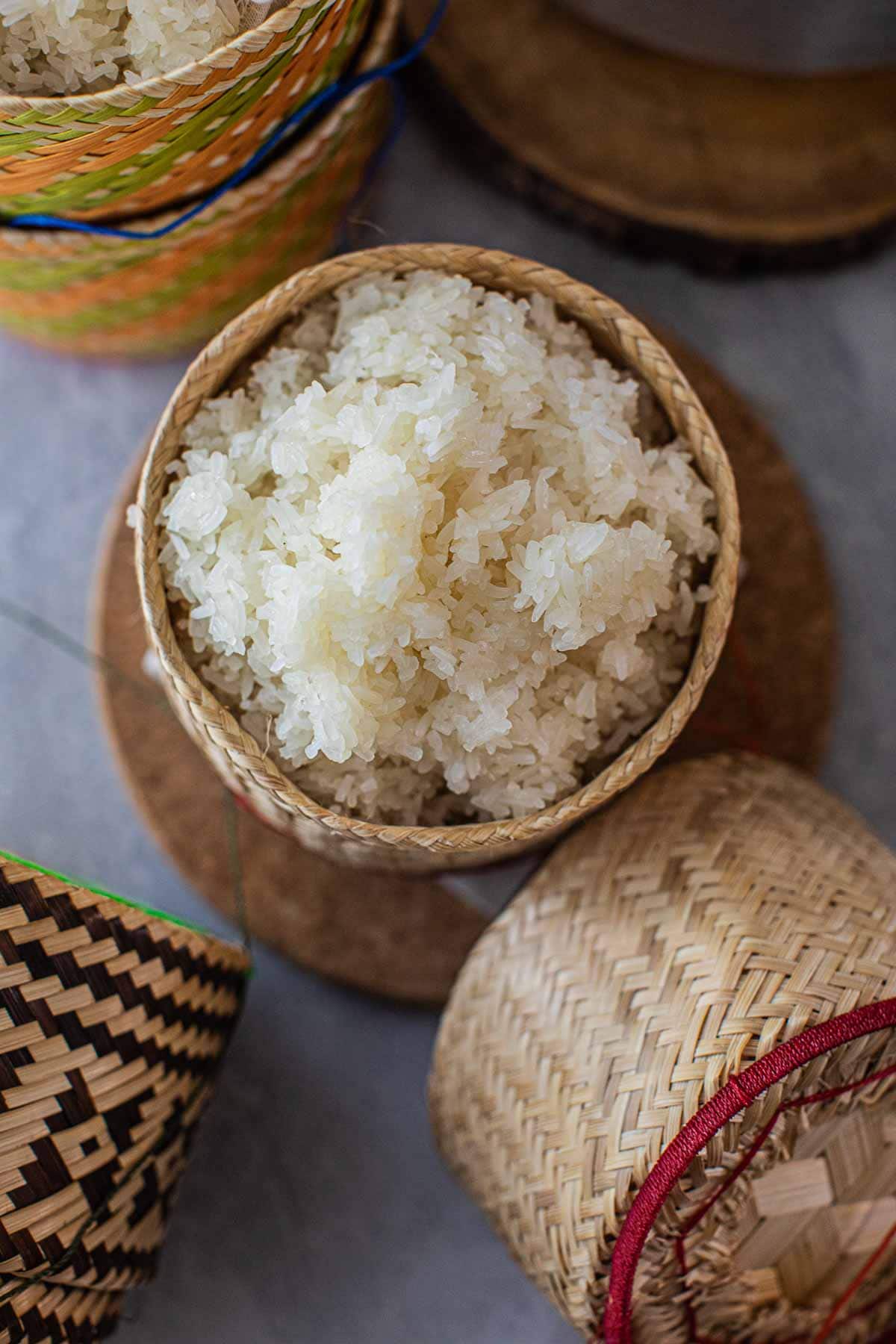
Sticky rice has been a cherished part of my life since childhood in Issan, Thailand, where it was a staple in nearly every meal. I grew up watching my mom prepare it early in the morning to carry with us to school, family trips, and even long days out in the rice fields. That firsthand experience allows me to guide you step-by-step to make this beloved dish exactly as it’s done in my hometown, making it easy and authentic for you to enjoy at home
Go here for a traditional method of making sticky rice using a bamboo steamer. Once you finish your perfect sticky rice, make this popular Thai sticky rice mango dessert and this delicious Khao Jee grilled rice patties recipe. Also, learn how to make this colorful fun purple sticky rice using this recipe here.
Learn more about the different types of Thai rice and how to use them in this blog post here.
Jump to:
- Why you'll love this Sticky Rice Recipe
- What is sticky rice?
- How Sticky Rice is Different from Other Rice
- Thai Sticky Rice Recipe Ingredients
- How to make sticky rice on the stovetop
- How to serve Thai Sticky Rice
- Easy Sticky Rice Recipe Tips
- Thai Sticky Rice Recipe Variations
- How to store Thai Sticky Rice
- Sticky Rice Recipe FAQs
- More Thai recipes you'll love
- Thai Sticky Rice Recipe
- Using a Durch oven or stock pot
- Pairing
Why you'll love this Sticky Rice Recipe
- It's easy! You won't need the traditional Thai bamboo basket, which is hard to find sometimes.
- Easy clean-up! Cleaning the bamboo basket can be tricky. Using a stainless steel or stock pot is much easier and faster to clean up.
- Save on storage space! You won't have to find extra space in your pantry for the extra tool.
Pros & Cons
The best part about finding a new cooking method is that it makes life easier. Without using the bamboo basket steamer, cleaning up is easier. Also, having extra room on the stove to cook multiple dishes, especially for parties, is much easier.
Don't get me wrong, cooking sticky rice traditionally is my favorite and best cooking method. But a busy family with young kiddos lends itself to finding quicker and easier ways to do things sometimes. Don't worry. Using this method won't compromise the great texture and taste of rice. This is just a different way of doing things.
What is sticky rice?
Sticky rice is a kind of rice that is popular in Thai, Laos, Cambodian, and other Asian cuisines. Once cooked, the rice grains expand and soften, and they have a sticky texture that glues the grains together, and they can be rolled into little balls to eat with your fingers. Sticky rice is a delicious Thai rice to cook and eat!
How Sticky Rice is Different from Other Rice
It is different from other types of rice used in Thai cooking. It is important to know the right type of rice to use. Sticky rice must be soaked in water for at least 4 hours before it's steamed, not cooked. In the traditional method of cooking sticky rice, water never touches the grains once on the stovetop. You can easily tell sticky rice apart because other types of rice do not have the obvious glue-like texture of sticky rice once cooked.
Thai Sticky Rice Recipe Ingredients
- Sticky rice. Sold at most Asian markets, or grab yours here.
- Water. You will need a few cups of water for rinsing, soaking, and steaming the sticky rice. The water ratio used in your steamer differs from pot to pot, but you are good to go as long as there's enough cold water at the bottom of the pot to boil for 20-25 minutes.
- Salt. Optional. Use a little bit to season the rice before eating.
The different types of sticky rice
There are a few kinds of rice labeled sticky rice or sweet rice. Look for Thai sticky rice from Thailand or with the word Thai on the label. Find these at Asian grocery stores or
They are long-grain rice similar to Japanese sticky rice though not the same. Japanese rice is a short-grain rice that looks and is cooked almost the same way as Thai sticky rice.
There is also glutinous black rice or forbidden rice. It's another Thai variety of rice enjoyed by Thai people.
Kitchen Tools for this Sticky Rice Recipe
- 6 quartz Dutch oven
- The metal steamer works great as a substitute for steaming sticky rice
- Cheesecloth
- Strainer or Colander
- Stainless steel steamer with handle
- Wooden spatula
How to make sticky rice on the stovetop
I'm sharing how to use two different kitchen tools to make this sticky rice recipe without a bamboo basket. Both are very similar. One uses a small steamer (My favorite), and the second uses a Dutch oven or stock pot. See the note at the bottom of the steps for using a Dutch oven or stock pot.
Using a stainless steel steamer
Step 1. Wash the sticky rice. Wash and rinse the sticky rice in a large bowl with cold water. Use your fingers to swoosh around the rice grains in the water. Drain the water and repeat the process 3-5 times until the water is mostly clear and not cloudy white. We do this to rinse off the rice's starch and help give the rice a soft and chewy texture once cooked. Use a strainer or splatter guard to catch the rice grains when pouring if you don't want to lose rice grains.

Step 2. Soak the rice in cold water for a minimum of 5 hours at room temperature for up to overnight for best results. No longer than 24 hours, the rice will get too soft, the grains will start breaking, and you'll get mushy rice.
Step 3. Steam the rice. Fill the bottom of the steamer pot with enough water to steam rice for up to 20-25 minutes without the water drying out. You'll need anywhere from4-6 cups of water, depending on the size of your pot. The water level should be low enough not to let the bottom of the bamboo basket touch it. Allow 1-2 inches of space between the water and the pot.
Step 4. Wash, drain, and rinse the soaked rice last time to remove any excess starch before steaming. Then line the steamer with cheesecloth, and place the rinsed rice over the cloth.

Step 5. Wrap the cheesecloth around the rice, cover it, and we'll start steaming! Turn the stovetop to high heat and steam the rice for 15-20 minutes.

Step 6. Check your rice 10-15 minutes into the steaming. (It's helpful to set the timer.) If the rice looks translucent and shiny, carefully take a small piece of cooked rice with a long fork or wooden spoon to see how it tastes. The steam is hot with boiling water, be careful.

Step 7. The rice should be cooked on the el dente side but not crunchy. If you love it as it is, it's done! If not, cook for another 5-10 minutes. Carefully open the cheesecloth, then use a wooden spatula to stir the rice around to get it cooked evenly. Cover it back with the lid and return to cooking for a few more minutes until done.

Step 8. Turn the heat off, and remove the steamer from the stove. Fluff the rice again, and leave the cheesecloth open. Let it cool for a few minutes. Sprinkle a little salt on the rice if you prefer some. Discard the excess water in the pot.
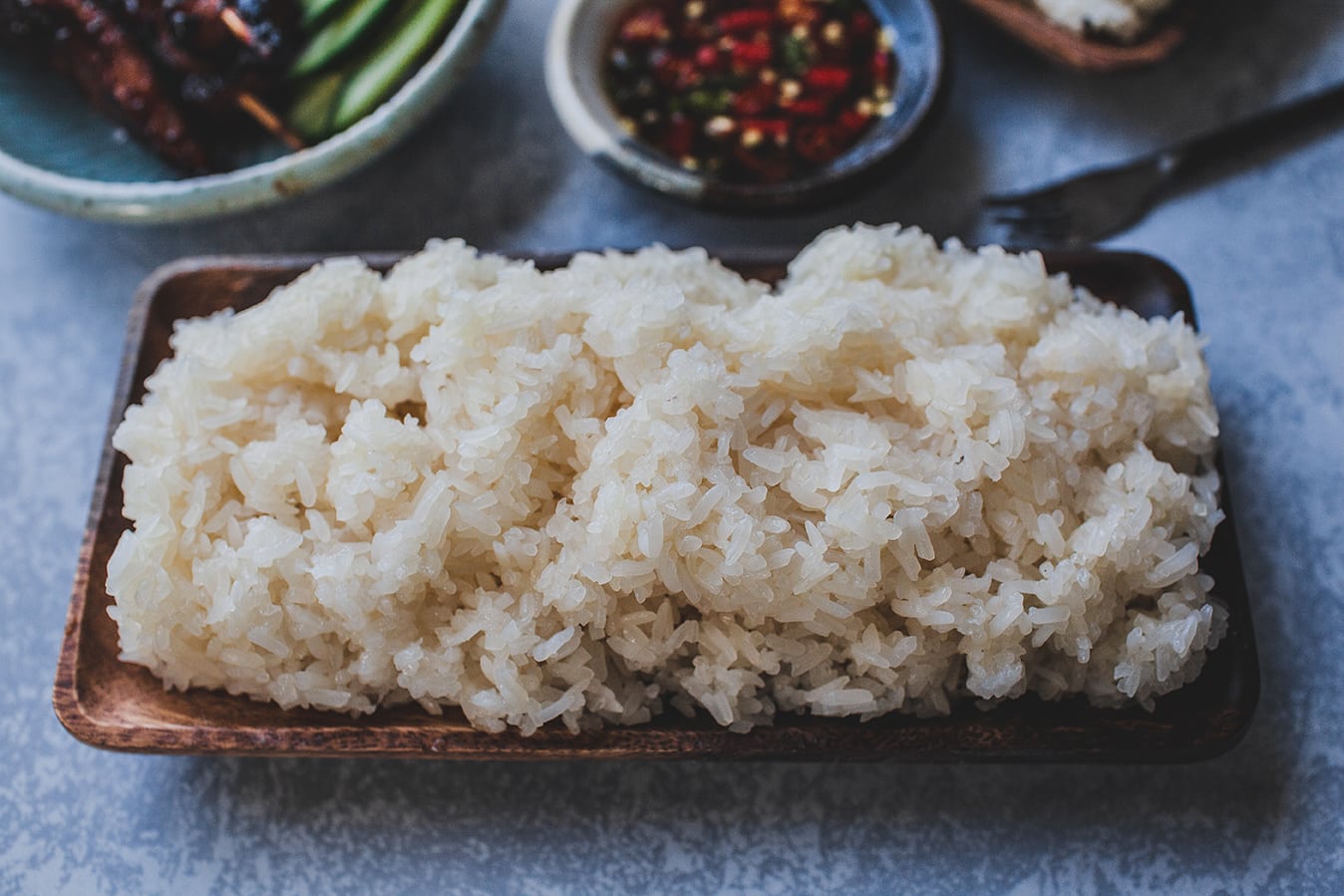
Using the Dutch oven or a stock pot
For this next method, you'll need a Dutch oven, a medium-sized stock pot, a strainer or colander, or a stainless steel steamer for this method. And also, use the cheesecloth for easy cleanup.
Steps 1-3. Prepare the rice using the same way from steps 1-3 above.
Step 4. Line the bottom of the Dutch oven or stock pot with a colander or a stainless steamer with water in the bottom of the Dutch oven. See the image below.
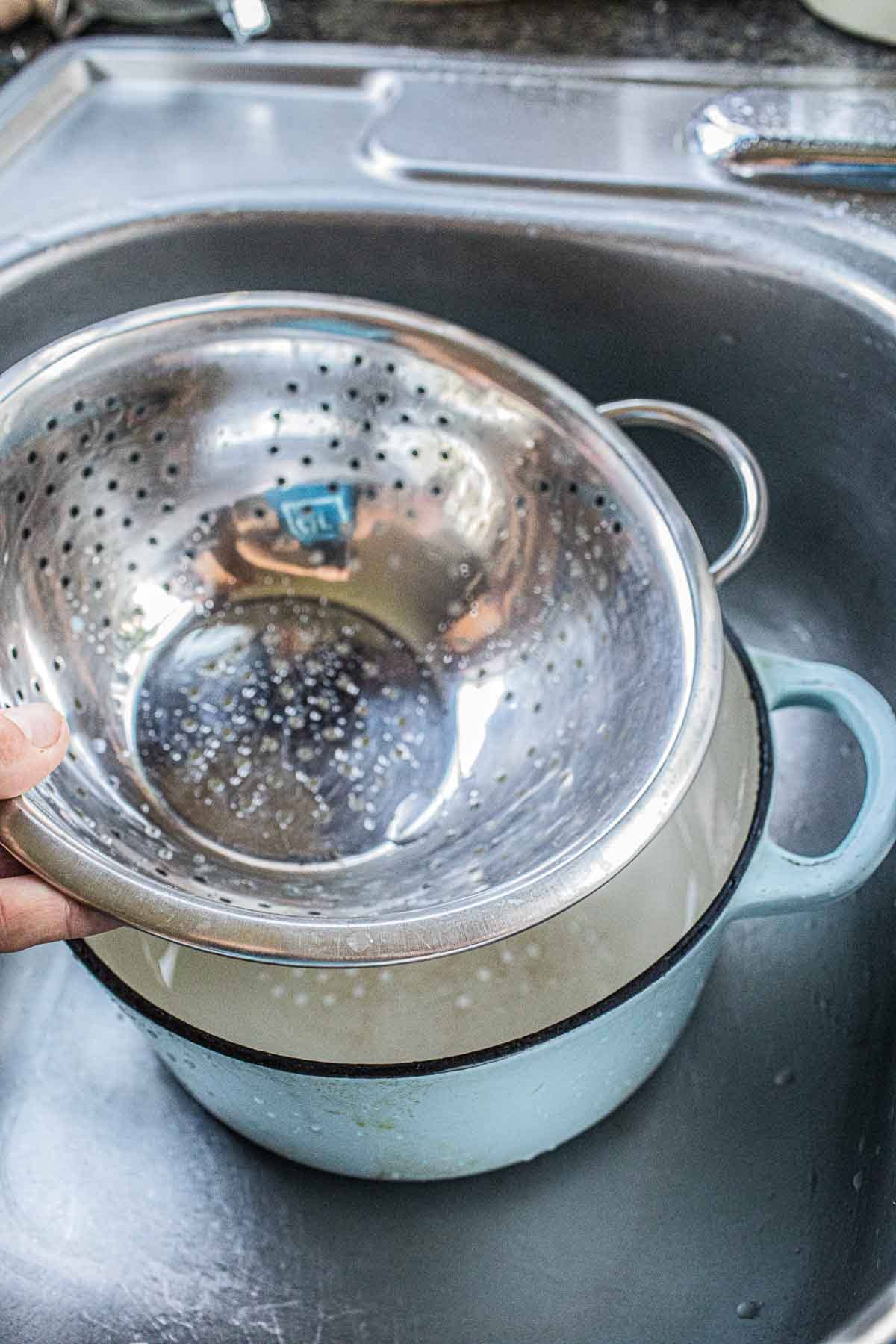
Step 5. Place the cheesecloth over the colander, and add the sticky rice inside the cloth. Make sure the strainer or colander doesn't touch the water in the bottom of the pot.

Step 6. Cover the pot with a lid and steam the rice following the same instructions from steps 5-8 above.

That's it! You basically make your own steamer using a few kitchen tools you already have!

How to serve Thai Sticky Rice
Thai Sticky Rice is perfect for serving alongside light dishes. Use these recipes to pair with your sticky rice. Easy Chicken Satay, Moo Ping, Thai BBQ meat, Thai Green Papaya Salad, or Grilled fish. Enjoy cooking! If you have leftover sticky rice, use this recipe to make a mango sticky rice dessert with coconut milk.
Easy Sticky Rice Recipe Tips
- Thai sticky rice MUST be soaked before cooking. This step is crucial. The soaking will help soften the grains before steaming. At least 5 hours of soaking is recommended for the rice to achieve the proper consistency when steamed. This top tip needs a little planning for making the perfect rice.
- The longer you soak the rice, the shorter the steaming time.
- Use a clear glass lid to cover the bamboo sticky rice steamer basket. It helps with seeing how the sticky rice is cooking.
- Right after the rice is done cooking, fluff the cooked rice on a flat surface like a baking sheet to allow the moisture to escape. This means using a fork or spoon to stir the rice to allow it to air out for 2-3 minutes before placing the warm rice in a serving container.
Thai Sticky Rice Recipe Variations
- Japanese sweet rice is another type of glutinous rice. It's not the same thing as Thai sticky rice, but it will cooked to the same consistency. It has shorter grains than Thai sticky rice.
- Black sticky rice (red or purple rice) is another type of long-grain sticky rice, and the cooking process is slightly different from white sticky rice. The black rice needs soaking time, and best to combine it with white rice before cooking. They can be found in most Asian markets. Check out my recipe here for using black rice to make purple sticky rice.
How to store Thai Sticky Rice
- Store your cooked sticky rice in a small sticky rice basket with the lid on. Leave the rice at room temperature for up to 2 days.
- If you don't have a sticky rice basket holder, store your rice in aluminum foil and fold it neatly to keep it soft. Keep at room temperature for up to 2 days.
- Store your leftover sticky rice in an airtight container. Keep it at room temperature for 2-3 days only.
Reheating Kao Neow
- Reheat your sticky rice in the microwave for a minute or so. Rub some water into the rice to add moisture back in, and it helps the rice grains soften when reheating.
- You can also reheat the rice in the steamer for a few minutes like you'd cook it initially. Use parchment paper to lightly cover the top of the rice to prevent drying.
Sticky Rice Recipe FAQs
Sticky rice has a high amount of Amylopectin, a starchy component that makes the rice sticky. Amylopectin is in starchy food like potatoes, cassava (think tapioca starch), wheat, and some root vegetables. Read more about the scientific terms of how rice works here.
Yes. Sticky rice must be washed a few times with cold water to remove impurities and starchiness from the rice grains until the water is clear before steaming it.
Nope. Jasmine rice is not sticky rice and will not be cooked, taste, or look the same as sticky rice.
Sticky rice can be made in various ways using various kitchen tools. It can be cooked in an instant pot, rice cooker, steamer, or microwave!
No, Shushi rice and sticky rice are not the same rice. Thai Sticky rice requires hours of soaking before steaming in a steamer and is used as a side dish, making desserts, or making various recipes. Shushi rice is a Japanese short-grained rice used to make sushi and desserts in Japanese cuisine.
Sticky rice is delicious rice from Laos, then Northern Thailand, and trickled down to Thailand Isaan region (Northeast) of Thailand. Now, it's being eaten and enjoyed throughout Southeast Asia and beyond.
In Thailand, sticky rice is considered the main eaten rice in Northern Thai food, especially in the Northeast of Thailand. However, many Asian countries also cook with glutinous Thai rice and use it in various recipes.
1. Find your sticky rice at your local Asian markets. Most stores will have them.
2. Grab them online at Amazon. Here are the brands I recommend. Three Rings brand, Cock on the Mountain Top brand, and Three Ladies Santapong brand.
More Thai recipes you'll love
Looking for more delicious Thai recipes? Try these:
**Love a recipe you've tried? Please leave a 5-star rating in the recipe card below and/or a review in the comments section further down the page. Or follow me on Facebook, Pinterest, or Instagram!**
Print
Thai Sticky Rice Recipe
- Total Time: 0 hours
- Yield: 6
- Diet: Gluten Free
Description
Learn how to make sticky rice (without a bamboo basket steamer). This stovetop method of making Thai sticky rice is easy, using kitchen tools you will likely already have at home.
Ingredients
- 2 cups sticky rice, uncooked
- 8-10 cups water. If your pot is larger, you may need more water.
- Salt. Optional. For sprinkling some to season the cooked rice.
Instructions
Using a stainless steel steamer
- Wash the sticky rice. Wash and rinse the sticky rice in a large bowl with cold water. Use your fingers to swoosh around the rice grains in the water. Drain the water and repeat the process 3-5 times until the water is mostly clear and not cloudy white. We do this to rinse off the rice's starch and help give the rice a soft and chewy texture once cooked. Use a strainer or splatter guard to catch the rice grains when pouring if you don't want to lose rice grains.
- Soak the rice in cold water for a minimum of 5 hours at room temperature for up to overnight for best results. No longer than 24 hours, the rice will get too soft, the grains will start breaking, and you'll get mushy rice.
- Steam the rice. Fill the bottom of the steamer pot with enough water to steam rice for up to 20-25 minutes without the water drying out. You'll need anywhere from4-6 cups of water, depending on the size of your pot. The water level should be low enough not to let the bottom of the bamboo basket touch it. Allow 1-2 inches of space between the water and the pot.
- Wash, drain, and rinse the soaked rice last time to remove any excess starch before steaming. Then line the steamer with cheesecloth, and place the rinsed rice over the cloth.
- Wrap the cheesecloth around the rice, cover it, and we'll start steaming! Turn the stovetop to high heat and steam the rice for 15-20 minutes.
- Check your rice 10-15 minutes into the steaming. (It's helpful to set the timer.) If the rice looks translucent and shiny, carefully take a small piece of cooked rice with a long fork or wooden spoon to see how it tastes. The steam is hot with boiling water, be careful.
- The rice should be cooked on the el dente side but not crunchy. If you love it as it is, it's done! If not, cook for another 5-10 minutes. Carefully open the cheesecloth, then use a wooden spatula to stir the rice around to get it cooked evenly. Cover it back with the lid and return to cooking for a few more minutes until done.
- Turn the heat off, and remove the steamer from the stove. Fluff the rice again, and leave the cheesecloth open. Let it cool for a few minutes. Sprinkle a little salt on the rice if you prefer some. Discard the excess water in the pot.
Using a Durch oven or stock pot
For this next method, you'll need a Dutch oven, a medium-sized stock pot, a strainer or colander, or a stainless steel steamer for this method. And also, use the cheesecloth for easy cleanup.
1. Prepare the rice using the same way from steps 1-3 above.
4. Line the bottom of the Dutch oven or stock pot with a colander or a stainless steamer with water in the bottom of the Dutch oven. See the image below.
5. Place the cheesecloth over the colander, and add the sticky rice inside the cloth. Make sure the strainer or colander doesn't touch the water in the bottom of the pot.
6-8. Cover the pot with a lid and steam the rice following the same instructions from steps 5-8 above.
That's it! You basically make your own steamer using a few kitchen tools you already have!
Notes
- Thai sticky rice MUST be soaked before cooking. This step is crucial. The soaking will help soften the grains before steaming. At least 5 hours of soaking is recommended for the rice to achieve the proper consistency when steamed. This top tip needs a little planning for making the perfect rice.
- The longer you soak the rice, the shorter the steaming time.
- Use a clear glass lid to cover the bamboo sticky rice steamer basket. It helps with seeing how the sticky rice is cooking.
- Right after the rice is done cooking, fluff the cooked rice on a flat surface like a baking sheet to allow the moisture to escape. This means using a fork or spoon to stir the rice to allow it to air out for 2-3 minutes before placing the warm rice in a serving container.
** Thank you so much for visiting my blog! This is truly a passion for me. If you have enjoyed these recipes and appreciate the hard work I put into them, I would love it if you would share them with your friends! Your recommendation is the highest review I could hope for, and I’d appreciate it! **
- Prep Time: 4-5 hours
- Cook Time: 25
- Category: rice
- Method: stovetop, steamed, boiling
- Cuisine: Thai
Pairing
These are my favorite drinks to serve with my favorite Thai dishes.

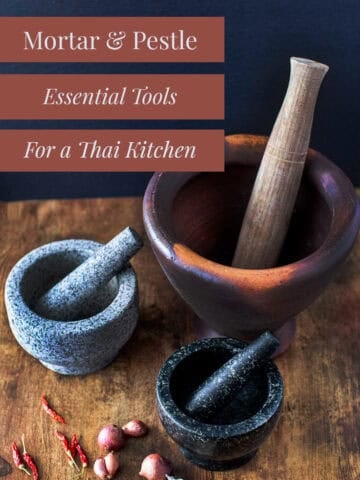




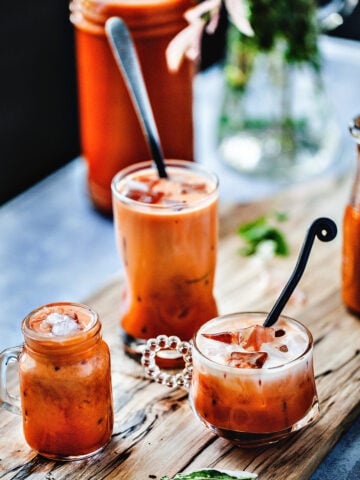



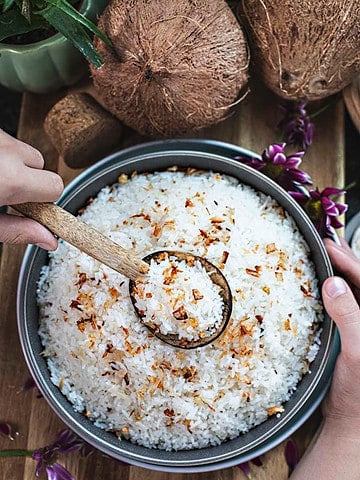
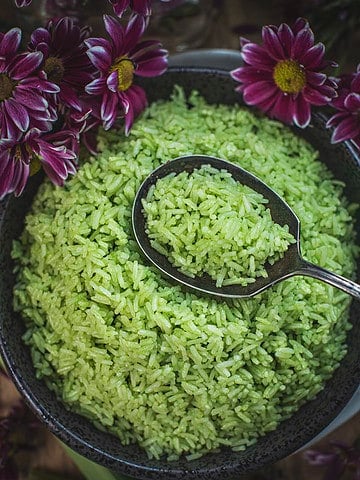
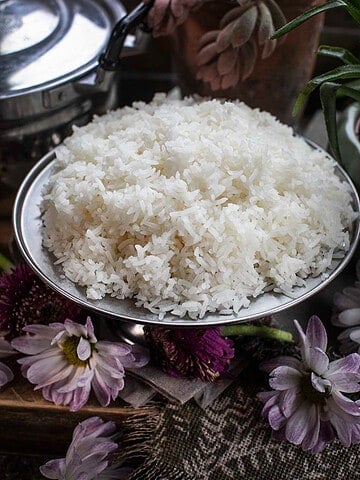
Ashley says
Yummmm! And easy! 5 stars
warapond lamdabmak says
Look nice I like your recipe